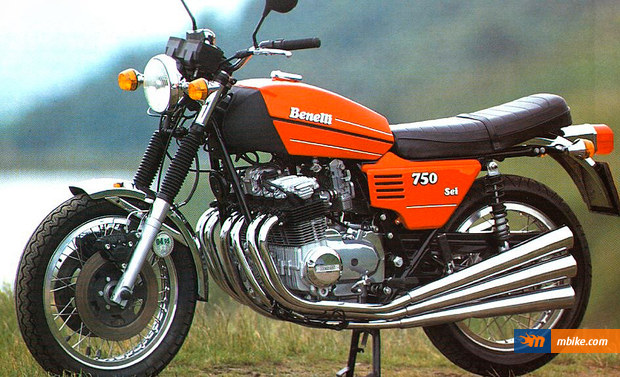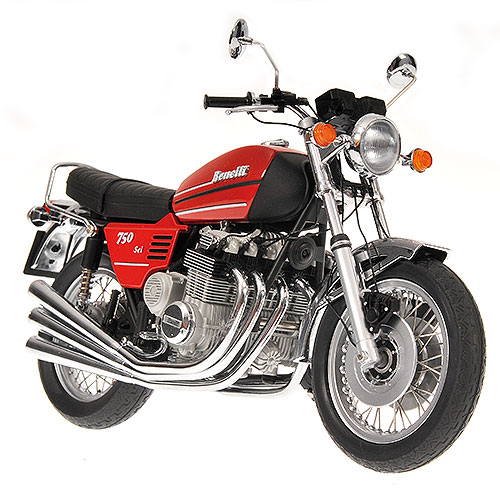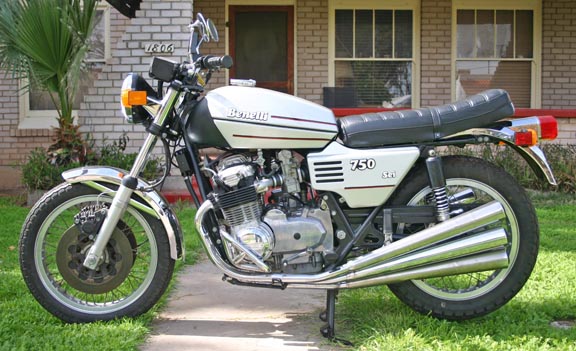Benelli 750 Sei
Straight-line speed was not the broad and softly tuned Benelli’s forte, but it cruised smoothly and effortlessly at speeds of 90mph (145km/h) and more.
The Benelli’s styling was conventional, but its engine width and number of exhaust pipes were certainly not. A luggage rack was an optional extra.
Benelli’s exotic six-cylinder superbike deserves a place in any history of fast motorcycles, despite one undeniable fact: by the standards of mid-1970s superbikes, it wasn’t outstandingly fast. The Italian machine was undeniably stylish, sophisticated and expensive but lacked the outright speed of the best Japanese superbikes and its Italian rivals alike.
Despite this the Sei was a fine all-round performer, combining effortless acceleration, remarkable smoothness and excellent handling in an eye-catching package topped by six gleaming chrome-plated exhaust mufflers. As well as being the only six-cylinder bike on the market when it was launched in 1974, the Sei also came with a pedigree. Benelli, based at Pesaro on Italy’s Adriatic coast, had won the 250cc world championship as recently as 1969, beating the two- strokes with a four-cylinder four-stroke ridden by Australian Kel Carruthers.
Inspired by Honda
Apart from its number of cylinders, the Sei's 748cc engine contained little innovative engineering, and was not outstandingly powerful despite a claimed peak output of 7 lbhp at 8500rpm. Cynics commented that the sohc unit was little more than one-and-a-half Honda CB500 motors. Like Honda’s four it featured cylinder dimensions of 56 x 50.6mm, and a central camchain. Similar details such as the ribbed oil filter housing also revealed the main inspiration of the Italian firm’s engineers.
But the Benelli motor also incorporated differences including its alternator, which sat not at the end of the crankshaft but behind the cylinders on the right, where it was driven by gears. That allowed the six-cylinder motor’s crankcases to be narrow, as did the use of only three 24mm Dell'Orto carburettors, the outer two of which fed angled inlet manifolds that allowed the carbs to be close together beneath the fuel tank.
The motor was tuned for mid-range performance and was impressively tractable, producing useful torque everywhere above 2000rpm in top gear. Carburation was crisp, and there was barely a step in the power delivery as the revs rose through the range. This meant that although the Benelli’s top speed of about l I5mph <I85km/h) was unexceptional, the bike impressed with its effortless high-speed cruising ability.
Rapid riding was also boosted by a chassis that was conventional in layout but which worked much better than most contemporary set-ups. The steel twin-cradle frame held Marzocchi forks, plus rear shocks either from the same firm or Sebac. Both ends were fairly firm in Italian sporting tradition. In combination with the reasonably rigid frame, that helped give good straight-line stability.
For a big bike the Benelli was also impressively agile, and could be cornered faster than many much smaller machines. It had fairly generous ground clearance, especially considering its engine layout. Powerful twin Brembo front disc brakes, backed up by a rear drum, added to the six-cylinder machine's impressive chassis performance.
Sadly for Benelli and particularly the firm's boss, Argentinean car baron Alejandro de Tomaso, the Sei was not a sales hit. Despite its array of cylinders the Benelli lacked the character and performance that made the best rival Italian superbikes popular. Potential owners were worried about reliability and high running costs as well as the bike’s considerable purchase price.
The Sei nevertheless remained in production with few changes until the end of the decade, when its engine was enlarged to produce the 900 Sei.
This had a little extra power and a neat headlamp fairing, but no more charisma. It sold in similarly small numbers and marked the end, at least for the next quarter century, of Benelli’s attempt to become a major superbike manufacturer.
Benelli emphasized the motor’s layout with three shiny silencers on each side, leaving the owner plenty1 of polishing work. The bike sounded good although the pipes were too efficient to allow full benefit of the six- cylinder unit.
The Sei’s large frontal area and broad fuel tank gave a rather heavy look. Although the Benelli was not a sportster in the Italian tradition, it was reasonably light and handled well. Big Brembo front brake discs supplied plenty of stopping power.
Specification Benelli 750 Sei (1975)
- Engine Air-cooled sohc 12-valve transverse six
- Capacity 748cc (56 x 50.6mm)
- Maximum power 71bhp @ 8500rpm
- Transmission Five-speed, chain final drive
- Frame Steel twin cradle
- Suspension Telescopic front; twin shocks rear
- Brakes Twin discs front; drum rear
- Weight 485lb (220kg)
- Top speed 115mph (185km/h)

























0 comments: